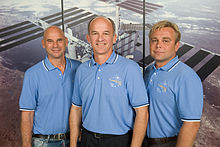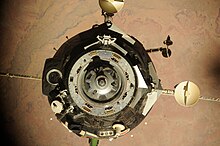 | |
| Mission type | ISS crew rotation |
|---|---|
| Operator | Roscosmos |
| COSPAR ID | 2009-053A |
| SATCAT no. | 35940 |
| Mission duration | 168 days |
| Spacecraft properties | |
| Spacecraft | Soyuz No.226 |
| Spacecraft type | Soyuz-TMA 11F732 |
| Manufacturer | Energia |
| Crew | |
| Crew size | 3 up 2 down |
| Members | Maksim Surayev Jeffrey Williams |
| Launching | Guy Laliberté |
| Start of mission | |
| Launch date | September 30, 2009, 07:14:45 (2009-09-30UTC07:14:45Z) UTC |
| Rocket | Soyuz-FG |
| Launch site | Baikonur 1/5 |
| End of mission | |
| Landing date | March 18, 2010, 11:24 (2010-03-18UTC11:25Z) UTC |
| Orbital parameters | |
| Reference system | Geocentric |
| Regime | Low Earth |
| Perigee altitude | 340 kilometres (210 mi) |
| Apogee altitude | 351 kilometres (218 mi) |
| Inclination | 51.6 degrees |
| Period | 91.44 minutes |
| Epoch | October 7, 2009 |
| Docking with ISS | |
| Docking port | Zvezda aft |
| Docking date | 2 October 2009 08:35 UTC |
| Undocking date | 21 January 2010 10:03 UTC |
| Time docked | 111d 1h 28m |
| Docking with ISS (Relocation) | |
| Docking port | Poisk zenith |
| Docking date | 21 January 2010 10:24 UTC |
| Undocking date | 18 March 2010 08:03 UTC |
| Time docked | 55d 21h 39m |
 From left to right: Laliberté, Williams and SurayevSoyuz programme (Crewed missions)← Soyuz TMA-15Soyuz TMA-17 → | |
The Soyuz TMA-16 (Russian: Союз TMA-16) was a crewed flight to and from the International Space Station (ISS). It transported two members of the Expedition 21 crew and a Canadian entrepreneur from the Baikonur Cosmodrome in Kazakhstan to the ISS. TMA-16 was the 103rd flight of a Soyuz spacecraft, the first flight launching in 1967. The launch of Soyuz TMA-16 marked the first time since 1969 that three Soyuz craft were in orbit simultaneously.
Guy Laliberté, founder and CEO of Cirque du Soleil, was a Space tourist aboard TMA-16 during its flight to the ISS, paying approximately US$35 million for his seat through the American firm Space Adventures. He returned on board the Soyuz TMA-14 spacecraft left as an emergency vehicle during that previous flight. The Soyuz TMA-16 flight spacecraft flew back to Earth with only two crew members.
Crew
| Position | Launching Crew Member | Landing Crew Member |
|---|---|---|
| Commander | Expedition 21 First spaceflight | |
| Flight Engineer | Expedition 21 Third spaceflight | |
| Spaceflight Participant | Only spaceflight Tourist |
None |
Backup Crew
| Position | Launching Crew Member | Landing Crew Member |
|---|---|---|
| Commander | ||
| Flight Engineer | ||
| Spaceflight Participant | Tourist |
None |
Mission highlights




Soyuz TMA-16 was docked to the ISS at the aft port of the Zvezda module. On January 21, 2010, cosmonaut Suraev and Expedition 22 Commander Jeffrey Williams relocated the spacecraft to the zenith-facing port of the Poisk module. The Soyuz TMA-16 spacecraft undocked from the aft end of the Zvezda service module at 5:03 a.m. EST and backed away to a distance of about 100 feet from the space station. Undocking occurred as the station flew about 213 miles high off the southwest coast of Africa. Re-docking occurred at 5:24 a.m. EST after Suraev fired the Soyuz maneuvering thrusters to fly halfway around the orbiting space station and line up with the Poisk module.
Spaceflight participant Guy Laliberté landed aboard Soyuz TMA-14 after approximately 12 days in space while Surayev and Williams landed aboard TMA-16 in Kazakhstan on March 18, 2010.
Space tourism status
Soyuz TMA-16 was the final flight of a space tourist to the International Space Station for more than a decade. With the imminent retirement of the Space Shuttle and the expansion of the station to six crew members, all Soyuz crew positions for the foreseeable future were to be occupied by Expedition crew until another crewed spacecraft such as Dragon 2 or Starliner was available to service the International Space Station.
References
- ^ NASA Assigns Space Station Crews, Updates Expedition Numbering Archived 2012-04-17 at the Wayback Machine - NASA press release - 08-306 - Nov. 21, 2008
- NASA. "Consolidated Launch Manifest". NASA. Archived from the original on March 7, 2009. Retrieved March 28, 2009.
- McDowell, Jonathan. "Satellite Catalog". Jonathan's Space Page. Retrieved January 22, 2014.
- ^ "Circus tycoon Guy Laliberté becomes first clown in space". London: guardian.co.uk. Associated Press. October 1, 2009. Retrieved October 1, 2009.
- NASA HQ (November 21, 2008). "NASA Assigns Space Station Crews, Updates Expedition Numbering". NASA. Archived from the original on April 17, 2012. Retrieved November 21, 2008.
- Жена главы компании Intel готовится стать космонавтом Archived 2012-02-14 at the Wayback Machine
- Stephen Clark (January 21, 2010). "Crew shifts Soyuz capsule to new station docking port". Spaceflightnow.com. Retrieved January 21, 2010.
- AFP (November 13, 2008). "Russia sees end of road for space tourism". The Sydney Morning Herald. Retrieved October 1, 2009.
External links
- Soyuz TMA-16 tracking
- Guy Laliberté in training Archived 2009-06-06 at the Wayback Machine
- Soyuz TMA-16 pictures
| Soyuz programme | |||||||||||||||||||||||||||
|---|---|---|---|---|---|---|---|---|---|---|---|---|---|---|---|---|---|---|---|---|---|---|---|---|---|---|---|
| Main topics |  | ||||||||||||||||||||||||||
| Past missions (by spacecraft type) |
| ||||||||||||||||||||||||||
| Current missions | |||||||||||||||||||||||||||
| Future missions | |||||||||||||||||||||||||||
| Uncrewed missions are designated as Kosmos instead of Soyuz; exceptions are noted "(uncrewed)". The † sign designates failed missions. Italics designates cancelled missions. | |||||||||||||||||||||||||||
| Human spaceflights to the International Space Station | ||
|---|---|---|
| See also: ISS expeditions, Uncrewed ISS flights | ||
| 1998–2004 |
|  |
| 2005–2009 | ||
| 2010–2014 | ||
| 2015–2019 |
| |
| Since 2020 |
| |
| Future | ||
| Individuals | ||
| Vehicles |
| |
| ||
| ← 2008Orbital launches in 20092010 → | |
|---|---|
| January | |
| February | |
| March | |
| April | |
| May | |
| June | |
| July | |
| August | |
| September | |
| October | |
| November | |
| December | |
| Launches are separated by dots ( • ), payloads by commas ( , ), multiple names for the same satellite by slashes ( / ). Crewed flights are underlined. Launch failures are marked with the † sign. Payloads deployed from other spacecraft are (enclosed in parentheses). | |